Archaeology and the Bible
The Gospels
| Nazareth | 32 42 22.15N 35 18 05.18E | Just south of the trees is the Virgin's Fountain while the square block a little to the north is the Greek Orthodox church of St Gabriel (or Church of the Annunciation). |
| Nazareth | 32 42 07.62N 35 17 52.27E | The Basilica of the Annunciation in Nazareth. The waste ground to the south was where militant Muslims erected a mosque as a deliberate provocation. I am happy to say that it was bulldozed by the Israeli authorities. |
| Machaerus | 31 34 02.46N 35 37 27.76E | The outline of the fortress can be clearly seen, but you need to tilt the map to appreciate that it is on a ridge, not down in a valley! |
| Capernaum | 32 52 50.14N 35 34 31.39E | The picture here is not the clearest, but the coordinates are of the apalling church erected over the alleged house of St Peter. The famous synagogue is the white rectangle just to the north. |
| Chorazin | 32 43 41.00N 35 33 50.48E | The coordinates are those of the synagogue of Chorazin. Once again, the picture is not the best, but the outline of the excavated area can be clearly seen. |
| Jacob's Well | 32 12 33.93N 35 17 06367E | The pink roof and dome of the newly built church can be clearly seen, but you will notice that there are no photographs of the well itself! Ignorant and superstitious monks naturally fear that the camera will extract the mana from their holy site. |
Christmas
One of the most vexed questions is the date of Jesus' birth. The traditional date of December 25 is rejected by all scholars as a polite fiction invented to give Christians an excuse for celebrating a winter festival along with their neighbours who were taking part in a more earthy festival over the lengthening of the day. (The fact is that even that is guesswork: there is no coherent account of how and why Christians began to celebrate December 25.)
The fact that Joseph and Mary had to travel to be registered for taxation makes winter a most unlikely time for the birth and any time between spring and autumn more probable. The fact that the shepherds were out in their fields guarding their sheep also points away from winter: Bethlehem is some 2,000 feet above sea level and in winter can receive quite heavy falls of snow even today and travellers' reports indicate that winters were more severe in previous centuries.
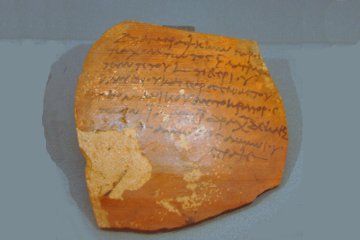
| |
| An ostracon from Aswan, now in Vienna, recording the payment of tax as part of a census conducted by Claudius in AD 45. |
However even fixing the year of Christ's birth is just as puzzling as the time of year. According to the Bible Joseph and Mary travelled to Bethlehem to be registered as part of a taxation decreed by Augustus, which was first carried out by the Roman governor Quirinius. Quirinius was a well-connected Roman nobleman who was appointed as governor of Syria in AD 6 following the banishment of Herod Archelaeus. Judea came under direct Roman rule and was, therefore, assessed for taxation which had previously been the responsibility of the Herods. This assessment was probably carried out in AD 7.
Augustus had instituted tax reform at the start of his rule and the areas covered by it had gradually been extended. Judea was one of the last affected owing to the value of Herod the Great as a friend as well as client king in charge of an important and turbulent state. There was a census of Palestine carried out under Varus, governor of Syria from 6-4 BC. Interestingly, Quirinius was engaged in military activities in the area at the time and it is not impossible - given how much the Jews resented foreign taxation - that he was called upon to provide some military muscle to back up those carrying out the census.
However the gospels are quite categoric that Jesus was born in the closing stages of the life of Herod the Great, who died in 4 BC. The magi saw a star prophesying or predicting the birth of Christ and arrived in Bethlehem an unstated period of time after the birth. The fact that Herod ordered the slaughter of all male children under two years of age indicates that a few months, at least, had passed since the magi saw the star. As Herod's final days are chronicled in some detail by Josephus, who depicts him as preoccupied with pain and the problem of the succession, it is quite possible that the Massacre of the Innocents might have happened in this final year of 4 BC - but then we must move Jesus' birth back to 5 or even 6 BC!
Attempts have been made to identify the year by reference to various astronomical phenomena which might have been the "star" seen by the magi. A popular one is a conjunction of Venus and Jupiter which occurred on June 17, 2 BC. This, of course, is impossible as Herod had been dead for two years by then. Kepler calculated a triple conjunction of Jupiter and Saturn in 7 BC when on three occasions the two planets came very close together - May 27, October 5 and December 1. Whether Luke or the magi would have regarded a conjunction as "a star" is open to question, but it is always possible that the magi said "conjunction" which was turned into "star" by the time the information reached Matthew.
The only other chronological information in the New Testament comes from Luke who gives a date for the start of John the Baptist's preaching (to be considred below) and remarks that shortly thereafter Jesus was "about thirty years of age". If we take that to be an exact statement, then it fits with a 4 BC birth; the "about" means that it would be consistent with a birth as early as 7 BC. It does, however, completely rule out AD 10, for if Jesus had been born in the first year of Quirinius, He would only have been about 16 when John started to preach and baptise.
The solution, it seems to me, is to view Luke's reference to Quirinius as parenthetical. The taxing was first ordered by Augustus while Herod was still alive and a few people actually presented themselves for registration before Herod had the taxation stopped or postponed. It was actually carried out, however, under Quirinius. Even if the registration was not compulsory at first, Joseph and Mary may have been glad of the excuse to escape from small town Nazareth and its gossiping inhabitants.
Some have rejected the gospel account, claiming that the Romans never required people to return to their ancestral homes for registration or taxation. In fact there is a provincial census decree from Egypt which orders precisely that:
Gaius Vivius Maximus, Prefect of Egypt: seeing that the time has come for the house to house census, it is necessary to compel all those who for any cause whatsoever are residing out of their provinces to return to their own homes, that they may both carry out the regular order of the census and may attend diligently to the cultivation of their allotments.
This order dates from AD 104, but there is no reason to think that similar rules might not have applied a century earlier. Other census documents found in Egypt actually give us the questions that were asked in such a census and which included name, father's name, occupation, wife's name, number and names of children, and so on.
Some are puzzled by the thought that Jesus was born in any year BC - after all, "BC" means "Before Christ"! As we have noted throughout this book, in acient times there was no universal chronology. Every event was dated in terms of a king's reign or after some notable natural event such as "after the earthquake". As time went by the cumberousness of this system was increasingly recognised and various "eras" were decreed to solve the problem. An early one was the system of Olympiads in Greece, but various rulers ordered that everything should be dated in terms of their own rule - the Era of Augustus, the Era of Diocletian, and so on.
The BC/AD system was invented by Dionysius Exiguus, a Scythian monk who lived around AD 470-544. The system did not become popular until it was used by the Venerable Bede (AD 673-735) in his Ecclesiastical History. Unfortunately Dionysius' calculations were not as accurate as they might have been (though no doubt he did his best!) and the result is that we have AD 1 happening some years after the birth of Christ. By now the system is so well-established that any attempt to alter it would result in far too much confusion to be tolerated.
Nazareth
Of course the Christmas story really begins in Nazareth, where both Joseph and Mary were living when the angel Gabriel announced to her that she would be the mother of the Messiah. Nazareth is not mentioned in the Old Testament, nor in any non-Biblical manuscripts until AD 200. Excavations by Fr Belarmino Bagatti on the site of the Church of the Annunciation between 1955 and 1965 uncovered pottery dating from the Middle Bronze to the Iron Age, but appeared to indicate that Nazareth was destroyed by the Assyrians and not inhabited again until Roman times.
This led some to dismiss Nazareth as a mere cluster of farm houses with a population of no more than 500. Indeed, the usual sceptics claimed that the lack of historical references to Nazareth in the first and second centuries AD "proved" that it did not exist in the time of Christ. However in 1995 the proprietor of one of the tourist shops on the main road below the Church of the Annunciation needed more space and began to dig in his cellar. He uncovered quantities of ash and a series of low tunnels which were eventually recognised as a Roman hypocaust (a heating system). The site was excavated by Yardena Alexandre in 1997/8 and identified as a Roman bath house, which continued in use down to the Ottoman period.
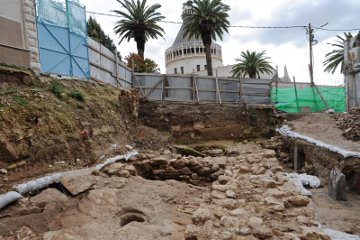
| |
| A recently discovered Roman period house in Nazareth. |
Alexandre also uncovered some typically Jewish buildings, indicating that there was a Jewish settlement in the area, but the presence of a Roman bath house indicates either a large Roman villa or, more likely, a Roman garrison. If the latter, then we can imagine the Romans choosing the deserted site of Nazareth for its commanding position overlooking the plain below and establishing a camp, both for military purposes and also, perhaps, as a hill retreat for soldiers from the unhealthy heat of the plain and the Rift Valley. The Jewish settlement would have sprung up around the camp as local people supplied the needs of the garrison for food and other requirements.
If we can imagine Nazareth as a sort of Roman R&R station we can see the point in Nathaniel's sardonic question, "Can anything good come out of Nazareth?" Roistering legionaries certainly did not provide the ideal environment in which to bring up a child and perhaps provided the background to the rumour, stated by Celsus, that Jesus' father was a Roman soldier called Panthera.
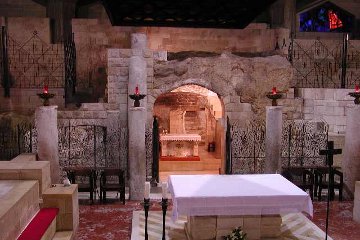
| |
| Ruins beneath the Church of the Annunciation are claimed to be those of the house of Mary and Joseph. |
Beneath the Church of the Annunciation some ruins have been uncovered which form the focus of intense devotion from Catholic pilgrims, for they are claimed to be the actual house of Joseph and Mary in which Jesus grew up. Needless to say, there is no archaeological merit in the claim whatsoever. The most that can be said - and I'm not even sure about this - is that they are the ruins of a house from the time of Jesus. The mere fact that ruins are found beneath a church does not give any special sanctity to those ruins. It is virtually impossible to build anywere in Palestine without discovering some ancient remains and so far as I know, the Catholics have only owned this land since the 1700s, so there isn't even a long tradition to which they can appeal.
For many years there has been a distinctive fountain in Nazareth known as the Virgin's Fountain, from which it is claimed that Mary drew water. That Mary drew water there is probably a safe bet, as it is the only fountain in the town, but the structure is relatively modern, as the brass tap testifies. In fact the water comes from a natural spring a hundred yards from it which is now covered by a Greek Orthodox church. However it is highly likely that the water from the spring ran through a channel - natural or artificial - down to the village lower down the hill, so it is unlikely that the Virgin toiled up the hill carrying her jar to fetch the water at either site.
The only date
There is only one date given in the New Testament and that is in Luke 3:1.
In the fifteenth year of the reign of Tiberius Caesar - when Pontius Pilate was governor of Judea, Herod tetrarch of Galilee, his brother Philip tetrarch of Iturea and Traconitis, and Lysanias tetrarch of Abilene - during the high priesthood of Annas and Caiaphas, the word of God came to John son of Zechariah in the desert.
Despite the seeming wealth of information about who was ruling where, none of those pinpoint a particular year. Only the 15th year of Tiberius refers to one year - but the trouble is to identify the year! Augustus died in AD 14, so it would be reasonable to take the 15th year to be AD 29. However Tiberius was appointed as co-regent with Augustus in AD 13, so his 15th year - if dated from that event - would be AD 28. As a further complication there is evidence that the Jews had their own system of counting the reigns of Gentile kings, using either autumn to autumn or spring to spring years.
To fix on a particular year, then, we have to make a number of assumptions. We have to decide whether Luke, a Greek (though possibly a proselyte) was using Roman years or Jewish ones - and if the latter, whether a spring or autumn year. We also have to decide whether Luke was counting from Tiberius' sole rule or his joint rule with Augustus. Finally we have to decide whether Luke was counting inclusively or exclusively. We are left with three possible years: AD 27/28, AD 28/29 or AD 29/30.
After looking into various arguments I prefer to date the fifteenth year to the year AD 27/28, but I cannot prove this beyond all doubt. There is the additional problem that whichever year it was, it was the year in which John the Baptist started to preach and it was an unknown number of months later that Jesus came to John to be baptised, which means that it is impossible to pinpoint the date of Jesus' baptism. All we can say is that it was sometime between AD 28 and AD 30.
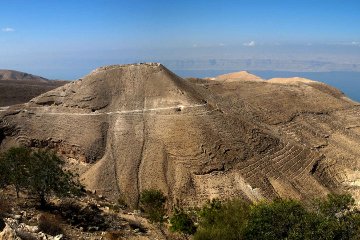
| |
| The grim fortress of Machaerus where John the Baptist was imprisoned and executed. |
John the Baptist was imprisoned by Herod Antipas for denouncing Herod's incestuous marriage to his niece (or possibly half-niece) Herodias, who had been married to his half-brother, Herod Philip II. A recent book claims that the marriage took place in AD 34 after the death of Philip, but the original documents - the Bible and Josephus - make it plain that Philip was still alive when Herodias left him. The usual date for this marital imbroglio is AD 27 and John's preaching would likely have come to the attention of the authorities some time later, perhaps as late as AD 28 but no later, unless Herod's spy service was woefully inadequate! This again points to the earlier date for the fifteenth year.
There is a tomb of John the Baptist in Samaria, but Josephus makes it plain that he was imprisoned in Machaerus, on the other side of the Jordan. The site was identified as long ago as 1807, but it was not excavated until 1968, when a substantial fortress was uncovered, together with traces of the siegeworks erected by the Romans in AD 72. Unlike the fanatics in Masada, the rebels in Machaerus surrendered before any blood was shed and were allowed to leave unharmed. No traces of John the Baptist or his imprisonment were discovered - but that would be too much to expect. The Herods did not commonly erect memorials to those they murdered.
It is unlikely that John's followers carried his body any great distance and even more unlikely that they would have been allowed to do so. The tomb of John the Baptist in Samaria is a fake and, needless to say, so are the various relics of the great man. I know of at least two heads of John the Baptist: one was in the parish church at Tenterden in Kent until the time of the Reformation and another was in Constantinople (Where it remains in the Topkapi Museum). Wikipedia (art. John the Baptist) has a list of another half dozen heads.
Capernaum
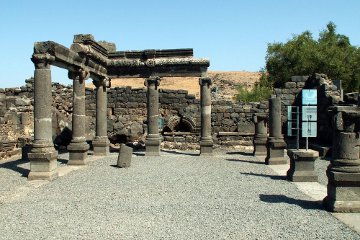
| |
| The black synagogue at Chorazin shows the sort of building in which Jesus would have preached and worshipped. |
When the Franciscans excavated in Capernaum they found the remains of an octagonal building a short distance to the south of the synagogue. Although small, it is very probably a church or chapel. This octagonal building had been erected over the foundations of one of the houses of the village and they not unnaturally leaped to the conclusion that it must have been the home of St Peter. (It would have been just as reasonable to conclude that it was the home of St Matthew or St James or St John or any other of the disciples who came from Capernaum!)
So far so good. They then determined to build a church over the ruins, but for many years a lack of funds prevented them doing so. Unfortunately they seem to have come into some money recently, because in the closing years of the Twentieth Century they erected a ghastly concrete flying saucer that is suspended over the ruins. As a church it is a pleasant enough building, but it is completely out of character with the site. To my mind piety can never excuse gratuitous vandalism - indeed, the building is little short of blasphemy and the glassed-over hole in the floor which allows you to look down on the ruins beneath is poor compensation for the stark simplicity of the home of Peter (or Matthew or James or John) which was so impressive before.
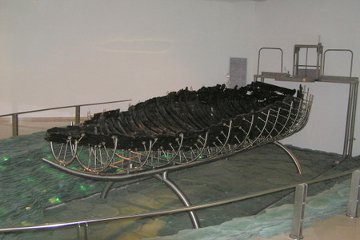
| |
| The Ginnosar Boat is difficult to photograph due to the low light in which it is kept. |
At the nearby Kibbutz Ginnosar there is a special museum preserving the remains of a boat that dates back to the first century AD. Discovered in 1986 when the water level in the Lake of Galilee was particularly low, the boat has since been preserved by soaking in special chemicals. The boat is interesting as an example of how boats were built in those days and the fact that it contains ten different types of wood indicates that the Galilee boat-builders were happy to use any old scrap of timber that came their way. That said, most of the planks are of Lebanese cedar and most of the frames are of oak.
I was intrigued to note that it has a place where a mast could be stepped, indicating that the boat could be sailed as well as rowed. The Talmud categorically states that boats on Galilee were not allowed to have sails, a piece of misinformation that should warn us to treat with caution other statements about temple buildings and services which are too often taken at face value.
Living Water
Of all the journeyings and miracles wrought by Jesus during His ministry, only one finds archaeological support. When Jesus was resting by a wall in Samaria He fell into conversation with a woman who had come to draw water. Jesus offered to give her "living water", prompting the sardonic response, "How can you do that seeing as You have no rope - and the well is deep."
A short distance outside the modern city of Nablus and quite close to the old Tel Balata of Shechem there is a well, which once stood in the open fields but since 1940 is in the basement of a Russian church. For many years this church was half-built, its floor and walls open to the sky. Funds to build it dried up when Russia turned communist and the flow of pilgrims ceased. Since the fall of communism, Russian pilgrims have returned to the Holy Land and I believe that the church is now completed.
Visitors to the site are conducted down a narrow flight of stairs to the crypt where a small cube of masonry stands proud of the floor. A small circular hole in the top of the cube is the mouth of the well, appropriately scored with grooves where the well-rope has cut into the stone. The guardian will let down the rope and pull up some water, from which you could drink safely - lovely clear, cool water - and then tip a few drops down the well. The length of time that elapses before the drops hit the water beneath are an indication of just how deep the well is - 128 feet!
When we first visited the well there was no problem about photography, but over the last few decades the Russian Orthodox priest has become allergic to cameras and forbids any photograph, which is a shame because this is one of the rareities of Palestine - a site that is genuinely associated with Jesus. There is no other well in the vicinity and it certainly fits the description of "deep". It's just a pity that the church and monastery spoil it - it was much easier to imagine Jesus looking up and seeing the "fields white for the harvest" when the well was in the open air.
The Path from Bethany
There is a story - probably apocryphal - about an architect who was commissioned to design and build a university. One of the design criteria was that the paths should be so well sited that students had no incentive to walk on the grass. In due course the project was finished and the network of buildings - dormitories, classrooms, library, administration block and dining room - were handed over to the university authorities. However when they moved into the new campus they discovered, to their annoyance, that the architect had neglected to construct any paths between the buildings. They contacted the architect, who apologised and promised to put matters right as soon as possible.
Three or four months later the architect and his team returned to the campus. By then the students had worn a number of paths in the grass as they tramped from dormitory to classroom, to the library and the dining room. The architect simply concreted over these routes - and from then on the students naturally kept to the paths and refrained from walking on the grass!
The point of the story is that natural paths remain in use, something that we in England are familiar with, for we have a network of "public footpaths", some of which can be proven to go back half a millennium or more and others we are sure date back to Saxon times or even to the Neolithic! A route that is convenient for people remains convenient so long as people wish to travel from A to B. As a quirky aside, there is said to be a modern road which has a slight unexplained kink in it. Eventually some surveyor discovered a 17th century map charting this road and discovered that three hundred years ago there was a tree growing there and the road had jinked around it. The tree was long gone, but the deviation in the road remained!

| |
| Photograph dated 1877 depicting three paths running up the side of the Mount of Olives from the Garden of Gethsemane at the foot of the hill. |
If you stand in the Haram in Jerusalem and look across the Kidron Valley to the Mount of Olives, you will notice that there are three paths coming down the side of the Mount and meeting at the Garden of Gethsemane. One branches left towards Mt Scopus, one heads straight up the side of the Mount towards the Church of the Ascension, the third goes off to the right, leading directly towards the village of Bethany.
I have collected a number of old travel books about the Middle East and one of them contains a grainy photograph dating to 1877. The side of the Mount is virtually bare, there is no church at the Garden of Gethsemane, but the three paths are clearly visible running up the rocky hillside. I have an even older book, illustrated with steel engravings. There is no date for the book, but on internal evidence I would place it around 1850. Again, the steel engraving of the Mount of Olives shows the same three paths.
In other words, as far back as we can trace them, these same three paths have existed - simply because they are the most convenient routes from A to B, or in the case of the righthand path, from Bethany to Jerusalem. This means that it is highly likely that these paths have existed right back to the time of Christ or even beyond - and that in turn means that when Jesus came from Bethany to Jerusalem at the beginning of Holy Week, we can be highly confident that He followed the path which tradition claims as the route of the Triumphal Entry.
Pilate
On our first visit to Caesarea in 1958 there was very little to be seen; in fact, the only real ruin was the little harbour where ancient stones could be seen lying in the sea (and I got drenched by an unexpected wave breaking over the wall). However by our next visit in 1969 the theatre at the southern end of the site had been excavated and was becoming something of a tourist attraction.
Of course, Roman theatres are common, but what made this one famous was the discovery in 1961 of a stone that had been re-used as a step - which meant that half of it had been chipped and worn away. The other half contained several lines of text, three of which could be read quite clearly.
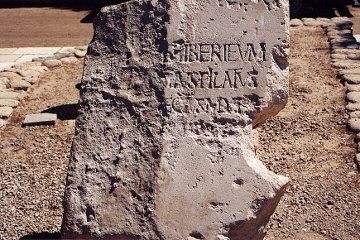
| |
| The reproduction of the Pontius Pilate inscription near the theatre in Caesarea. |
...TIBERIEUM
...TIUSPILATUS
...ECTUSIUDA...
It is not difficult to restore this as something like, "During the reign of Tiberius, Pontius Pilatus, Prefectus of Iudaeae". Presumably this was originally part of a dedicatory inscription, either beneath a statue of the procurator or, more likely, beneath a statue he had dedicated, either to Tiberius or to one of the gods. The inscription is currently housed in the Israel Museum in Jerusalem, but a reproduction of the stone is at Caesarea close to where it was found.
The importance of this inscription is that the usual sceptics (including some who call themselves "Biblical scholars"!) claimed that Pilate was a mythical character. The fact that he appears extensively in both Josephus and Philo, whose description of him as a weak and villainous individual entirely accords with the glimpse we have of him in the Gospels, is irrelevant so long as doubt can be cast on the Bible.
Interestingly, Tacitus also mentions Pilate but gives him the title of "procurator", whereas the inscription refers to him as "praefect". The early governors of Judea were indeed prefects and it was only in AD 44 that Cuspius Fadus was sent out as procurator.
Calvary and the Tomb
We now turn to the vexed question of the location of Calvary and the tomb of Christ. There are only two claimants: the first is the venerable Church of the Holy Sepulchre, which contains within it the alleged site of Calvary and the alleged tomb; the other is the Garden Tomb, which again has the alleged tomb within its grounds and a skull-shaped hill just outside.
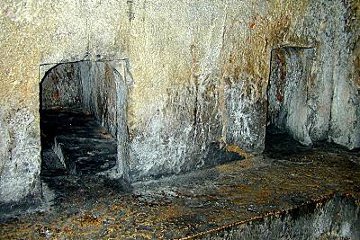
| |
| Typical 1st century AD kokhim in the Tombs of the Kings, Jerusalem. These were closed with a neatly cut slab of stone (now missing). |
The first point to notice is that in the first century AD Jewish tombs had a very distinctive form. (of course, we have no idea how the ordinary people were buried and can only state how the rich were buried, but as Jesus was laid in a rich man's tomb, our knowledge in this respect is pertinent.) A tomb consisted of one or more rooms carved into the rock and entered by a doorway, which could be closed by a stone, frequently a circular stone like a solid wheel. Inside the rooms at floor level there were cut a number of small, dead-end tunnels approximately the size of a coffin.
As each family member died, he or she was wrapped in a shroud that was fastened in place with bandages (a bit like an Egyptian mummy) and then the body was pushed into one of these "tunnels" - the official name is kokhim - which might then be closed by a stone slab. The body was left there for twelve months, by which time the flesh would have decayed away, and then the bones were dragged out and put in a stone box just long enough to take the leg bones. This box was called an ossuary.
Although we cannot prove that the tomb of Joseph of Arimathea was of this type, we can say that it would be highly unusual for someone at that period to have a different type of tomb. If we are correct in assuming that Joseph's tomb was a kokhim tomb, then neither the Garden Tomb, with its two stone boxes, nor the Holy Sepulchre, with its marble shelf, can possibly be the tomb of Jesus.
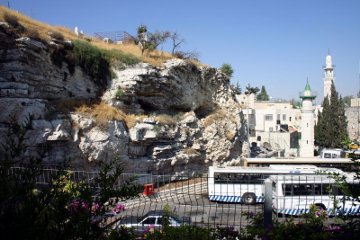
| |
| The modern bus station obscures the "skull", hiding the mouth almost completely. |
There is a further reason for dismissing the Garden Tomb, beautiful though it is. There is no tradition associated with the place; it was identified by General Charles Gordon who, while having tea with some friends whose house was on the north wall of the Old City, spotted the resemblance of the cliff opposite the wall to a skull - two eyes, a protruding nose, a mouth. This cliff and the hill behind it is still known as "Gordon's Calvary" in his honour.
Regrettably, in my lifetime the prominent "nose" has broken away thanks to weathering of the soft limestone and there is evidence that the cliff itself is a relatively recent quarry, no earlier than the building of the walls of Jerusalem in the mid-1500s. The "eyes" and "mouth" are natural caves, but limestone is notorious for the number of caves and holes it contains. It seems highly likely, therefore, that Gordon's Calvary is nothing to do with the crucifixion of Christ and if so, then the nearby tomb is also nothing to do with Christ.
There is, however, a tradition associating the Holy Sepulchre with Christ; allegedly when Hadrian conquered Jerusalem following the Bar Kokha revolt he ordered a temple of Venus to be built on the spot venerated by the Christians (a pestilential Jewish sect, in his eyes). That temple stood there until the conversion of Constantine some 200 years later, by which time although people might still believe that the tomb of Christ lay beneath the temple, there would be no one alive who remembered exactly what that tomb had looked like.
When Constantine had the temple demolished and the ground cleared, his workmen discovered a number of tombs and naturally fastened on the largest and most prominent as the one they were seeking. The tomb was excavated into a knoll and they carefully cut away the knoll to leave the tomb chamber as a little room with solid rock walls.
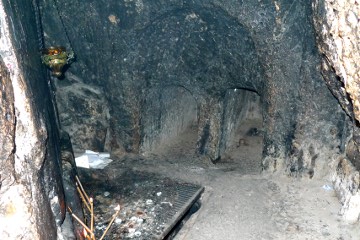
| |
| One of these two kohim in the Chapel of Nicodemus may be the actual grave of Christ. |
If you visit the Holy Sepulchre, by all means queue up to go inside the tomb - and if you are of a pious frame of mind, kneel down and say a prayer - but then go round behind the tomb. There is a doorway leading into a rather dusty room known as the Chapel of Nicodemus, off which there is a second room, in the far wall of which are two kokhim. Not knowing the first century Jewish burial customs, these were totally ignored by Constantine's workmen, but if the tradition linking this site with the tomb of Christ is correct - and I see no reason why it may not be - then it could very well be that one of these kokhim is the actual tomb!
If so, then I see an additional significance in a detail mentioned in the gospels. The gospel of John records that there was something significant about the linen clothes in which Jesus' body had been wrapped, something which, when John saw, persuaded him to believe. (John 20:8) However the other gospels make it plain that the disciples - including John - when they saw Jesus, were expecting Him to be a spirit or ghost.
It has been suggested that when Jesus was resurrected, His body simply passed through the grave clothes as it was later to pass through the locked door of the upper room, leaving the shroud and bandages lying as if a body was still within them. When touched, of course, the clothes collapsed, for they were empty. To arrange grave clothes like that on a shelf or inside a spacious box would be difficult but not impossible. To do it within the confines of a kokhim would be impossible!
If John came in and saw the shroud and bandages in the shape of a body, yet empty when he touched them, he would be convinced that Jesus' body had been removed by supernatural means. At the same time he would believe that Jesus was a spirit or ghost and he would communicate this belief to his fellow disciples. It was only when Jesus offered Himself to be touched, and ate and drank in front of them, that the disciples understood that He was a solid, real body.
However here we are leaving the solid, tangible world of archaeology, so let's get back to it. If the tomb of Christ is within or near the confines of the Church of the Holy Sepulchre, then Calvary must be close by. The presence of the kokhim is evidence that this area was outside the city walls, for the Romans forbade burial inside a city. It need not have been far from the walls, for Jews then - as now - desire to be buried as close to Jerusalem as possible. Jesus may well have been executed near this spot outside the walls and near a gate and road so that all who passed by could see and fear.
Whether the Calvary inside the church is the actual spot is another matter entirely. It is probable that Constantine's workmen simply picked the highest point preserved beneath the temple of Venus as the "hill of Calvary". Jesus and the two thieves would have been crucified near the road, not necessarily on a hill or even a knoll. In other words, we can have no certainty about the location of the tomb and even less about the site of the crucifixion.
Antonia
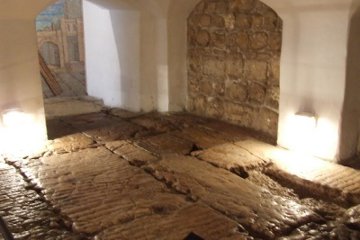
| |
| At one time these stones were thought to be the courtyard of the Antonia from the time of Christ. |
Excavations beneath the convent of the Dames de Sion, a French order of nuns, revealed a substantial Roman pavement and for a long time this was thought to be part of the Antonia. Unfortunately further exploration, which involved lifting some of these paving stones, revealed coins of the third century AD beneath the stones and the good sisters had to abandon the claim. However the same excavations also uncovered a substantial cistern, so it is likely that the Antonia stood very close to the pavement.
Preserved in the same convent is a Roman arch which the sisters firmly believe marks the spot where Pilate said, "Behold the Man!" (Ecce Homo in Latin). It is, in fact, a side arch from a triple gateway in a triumphal arch erected by the Emperor Hadrian around AD 132. The central arch spans the Via Dolorosa outside the convent and the other side arch is no doubt preserved in one of the buildings on the other side of the street.
The Via Dolorosa is a modern route which may or may not follow the course of ancient streets. In a couple of places Roman period paving stones have been discovered twenty feet below the present street level and brought up to the surface where they are being rapidly worn away by modern traffic. Nevertheless, the Via is the shortest route from Antonia to the Holy Sepulchre and no doubt Jesus carried His cross along a road twenty feet lower and close to the route followed by the modern pilgrims.
Other sites in and around Jerusalem are uniformly spurious. Gethsemane is almost certainly not the place where Jesus prayed and the trees, though ancient, are not the ones He knew for in the Roman siege of Jerusalem in AD 70 every tree for miles around was cut down either for fuel for the army or to make siege works. The Coenaculum is a Moslem prayer hall, the so-called "palace of Caiaphas" beneath the church of St Peter Gallicantu is simply a ruin with nothing to link it to the high priest - in fact, there is literary evidence to suggest that during the mediaeval period the two swapped places! Lazy or ignorant guides pointed pilgrims to the nearer site on Mt Zion as the Upper Room when in fact it was the site of Caiaphas' palace.
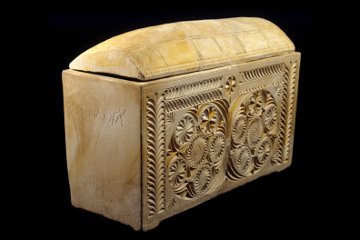
| |
| An ossuary inscribed "Joseph son of Caiphas" which was discovered in a tomb in the Kidron Valley. |
In the Kidron Valley south of the Old City a large cave tomb was discovered a few years ago and excavated by Z. Greenhut. It contained a number of ossuaries, the most elaborate of which had a Hebrew inscription scratched into the side, saying "Yehosef bar Caifa" - Joseph the son of Caiaphas! This is the first time that the name "Caiaphas" has been found in Hebrew and the fact that it was properly excavated - rather than purchased from an antiques dealer - means that the questions of authenticity that trouble the James Ossuary do not arise.
A tomb to the north of the Old City excavated in 1968 contained another collection of ossuaries, in one of which the excavators discovered an iron nail piercing a shattered heel bone. Adhering to the sharp end of the nail were fragments of wood. It seems that when the executioners hammered in the nail, it hit a knot of harder wood and the point of the nail bent like a fish-hook. When the relatives of this Yehonan ben-Hagkol came to take the body down it was impossible to pull the nail out - the head was hard against the flesh of his leg and it was impossible to get decent leverage - so they had to cut the wood away and bury the man with the nail still in his ankle.
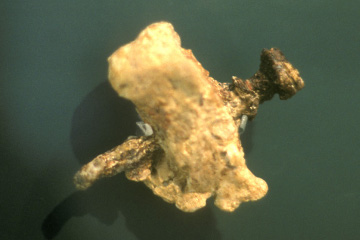
| |
| The heel-bone of Yohanan ben-Hagkol, on display in the Rockerfeller Museum in Jerusalem. |
This discovery raises questions about the posture of the crucified man. Traditional crucifixes show Christ's feet in front of Him, usually nailed to a small projection from the cross. Nails through the side of the ankle indicate that either the feet were awkwardly bent sideways and nailed to the front of the cross, or one foot was nailed to each side of the cross upright. Neither position can have been terribly comfortable - but I suppose that comfort was the last thing in which the Romans were interested!
Yehonan ben-Hagkol is the only crucified person ever discovered, which is surprising consider the thousands who were executed by this method in Israel alone. Most were probably tied to their crosses - iron was valuable, rope was cheap - but if nails were used, they were either extracted for reuse or even taken as protective charms by superstitious people.
The Talpiot Tomb
In 1980 construction work in the area of Talpiot, some six miles south of Jerusalem, uncovered a tomb containing six kokhim and two arcosolia. Inside the kokhim were ten ossuaries, all of which contained badly deteriorated human remains and six of which bore rough inscriptions. Three skulls and other crushed bones were found in the dirt that filled the tomb.
The names scratched on the ossuaries were Yeshua bar Yehosef, Maria, Yose, Yehuda bar Yeshua, Maramene e Mara and Matya. The first is very familiar: Jesus son of Joseph! Maria is Mary and Jose and Judas were brothers of Jesus. (Note that the ossuary says "Judah, son of Jesus", which is not the same thing at all!) A sensationalist television programme claimed that the tomb was that of Jesus of Nazareth and cited statistics as evidence that all these names together "prove" that no other family could have been buried here.
Learned arguments have raged over the statistical evidence, but it should be noted that even if the statistics could be calculated to give millions to one against it being any other family, that is still not proof - after all, people win the lottery despite the millions to one chance against them doing so! The archaeologists, including Amos Kloner who was responsible for excavating the tomb, reject the idea that this could be the tomb of Jesus, as do most scholars.
The only thing that might be able to throw light on the subject - a DNA analysis of the bones - is impossible because in accordance with standard practice, the bones were handed over to Orthodox Jews who buried them. Even if the burial place is known, the Orthdox would certainly not permit them to be disturbed again, which is a pity. If we could discover that Maria was the mother of Jesus son of Joseph, that would strengthen the claim that this is the Jesus' family tomb. If we found that Maramene or Mariamne, claimed by the film maker to be Mary Magdalene, was the mother of Judas and Jesus his father, we might almost come to believe Dan Brown's nonsense. On the other hand, if different family relationships were discovered, it would disprove the claim and show that despite the similarity of names, the Talpiot Tomb had nothing to do with Jesus of Nazareth.
Perhaps more interesting than this non-discovery is the genuine find of another tomb in Talpiot back in 1945 which was examined by Professor E. L. Sukenik and excavated by the Museum of Jewish Antiquities. The unopened tomb contained eleven ossuaries. Pottery and coins found in the tomb, as well as the style of writing on the ossuaries, meant that it could be dated to around AD 43. Five of the ossuaries bore inscriptions, three in Aramaic and two in Greek. The names on them were Simeon Barsaba, Miriam daughter of Simeon, and Mat - short for Mattathias. The Greek inscriptions were less easy to read, but both ended in the word "Iesou", one reading "Iesou Iou" and the other "Iesou Aloth".
"Iou" and "Aloth" could, of course, be proper names, if unusual ones, but another suggestion is that they are part of an invocation of Jesus. "Iesou Iou" could be read as "Jesus woe" (in the sense of "Lord have mercy") and "Iesou Aloth" as "Jesus is risen". This interpretation is strengthened by the fact that the second of these ossuaries had crosses drawn on each side in charcoal. It would seem, then, that less than twenty years after Jesus' death people were invoking His name as part of their funerary ceremonies.
it is not impossible In 1764 an inscription was found in Tivoli, just outside Rome, near the villa believed to have belonged to Quintillus Varus. The name which should have gone with the inscription was missing, but the words noted that this person had been twice "imperial legate" in Syria. We are pretty certain that Varus was never twice legate or governor of Syria, so it has been suggested that the inscription really refers to Quirinius. Others have pointed out that the Greek word "while" can also be translated as "before", so Luke may have actually said, "this census was carried out before Quirinius was governor of Syria. Return
after the birth Whereas Jesus' birth is said to have taken place in a stable attached to an inn, by the time the magi arrived He was "in the house", indicating that time had passed and the family had settled down in a rented or borrowed property. Return
first ordered by Augustus An inscription found in a temple of Augustus in Ankara, Turkey, refers to a census ordered by Augustus in 8 BC. Another possibility is a combined census and oath of allegiance ordered in 2 BC to mark the 25th anniversary of Augustus' seizure of power. Those who favour this date are obliged to suppose that Herod the Great did not die until 1 BC, which seems unlikely. Personally I favour the 8 BC date, supposing a delay between the issuing of the decree and its execution in Judea, which meant that the census was not actually carried out until 7 BC. Return
inclusively or exclusively In the west we tend to count ages exclusively, thus we say that a child is one year old during the period that he is 13-24 months old. In the east people commonly count inclusively and say that a child is one year old during the period that he is 1-12 months old. Thus Luke's "fifteenth year" could be the year after Tiberius had completed 14 years on the throne or it could be the year after he had completed 15 years. Unfortunately the additional information given by Luke does not help us to choose between these possibilities. Return
we cannot prove There was another type of tomb around in the 1st century. An arched recess cut in the wall of the tomb to leave a shelf about three feet off the ground, on which a full-size stone coffin or sarcophagus would be placed. There are a number of such arcosolia in tombs in Petra and a number are in the "Tombs of the Kings" (really the tomb of Queen Helena of Adiabene) in Jerusalem. This again rules out the Garden Tomb, for the graves in the room are not arcosolia and probably rules out the Holy Sepulchre as well, except that it is just possible that el-Hakim's destruction may have removed all traces of an arcosolium apart from the shelf - now a marble slab.
There is an interesting summary of the Second Temple tombs on the Ministry of Foreign Affairs website. Return
a little room This room then formed the focus first for an open circular courtyard built around it and then for a roofed space. Under the mad Egyptian caliph Hakim, the church was demolished and the room destroyed, but the workmen, with typical Eastern inefficiency, simply started at the top and hammered away, letting the stone chips fall where they would. When they had finished the area was a waste of broken stone - but the stone chips hid walls that still stood knee high or higher. After Hakim's mysterious disappearance, the Christians cleared away the stone, found the outline of the room and rebuilt the present tomb on top of the broken walls. Return
a collection of ossuaries As an indication of the turbulence of the times, the tomb contained the remains of 35 individuals, nine of whom had died of violence and an examination of the skeletons revealed that others appeared to have died of malnutrition or possibly even starvation. It is interesting that Josephus records that one high priest at this time was so greedy for gain that he sent his servants round to seize the tithes gathered by the ordinary priests, leaving them to starve to death.
The so-called "Burnt House", a private excavation in the Old City of Jerusalem, has a stone weight bearing the name "Bar Kathros", almost certainly a member of the priestly house which abused its position to gain great wealth. The Talmud castigates such priests in a poem repeated by Abba Saul ben-Batnith in the name of Abbba Joseph ben-Hanin:
Woe is me on account of the house of Baithos,
Woe is me on account of their rods.
Woe is me through the house of Hanin and through their calumnies,
Woe is me through the house of Kathros and through their pens,
Woe is me on account of the house of Ishmael ben Piakhi and of their fists,
For they were all high-priests,
Their sons were the treasurers,
Their sons-in-law were the chamberlains,
Their servants would beat us with rods.
Simeon Barsaba Sukenik suggested that the tomb may have belonged to the Barsaba family mentioned in the book of Acts, where "Joseph called Barsabas" was one of the two candidates for inclusion among the apostles in place of Judas, and "Judas named Barsabas" was sent to Antioch as one of the representatives of the Jerusalem church following the council of Acts 15. It would seem that the Barsaba family was prominent in Christian circles. Return





